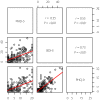Validity of the short-form five-item Problem Area in Diabetes questionnaire as a depression screening tool in type 2 diabetes mellitus patients
- PMID: 37409708
- PMCID: PMC10445190
- DOI: 10.1111/jdi.14051
Validity of the short-form five-item Problem Area in Diabetes questionnaire as a depression screening tool in type 2 diabetes mellitus patients
Abstract
Aims/introduction: Depression is prevalent in diabetes patients and associated with poor outcomes, but is currently underdiagnosed, with no firm consensus on screening methods. We evaluated the validity of the short-form five-item Problem Areas in Diabetes (PAID-5) questionnaire as a screening tool for depression, comparing it with the Beck Depression Inventory-II (BDI-II) and nine-item Patient Health Questionnaire (PHQ-9).
Materials and methods: A total of 208 English-speaking adults with type 2 diabetes, recruited from outpatient clinics, completed the BDI-II, PHQ-9 and PAID-5 questionnaires in English. Cronbach's α was used for internal reliability. Convergent validity was examined with BDI-II and PHQ-9. Receiver operating characteristics analyses were used to identify optimal PAID-5 cut-offs for the diagnosis of depression.
Results: All three screening tools were highly reliable, with BDI-II, PHQ-9 and PAID-5 having a Cronbach's α of 0.910, 0.870 and 0.940, respectively. There was a good correlation between BDI-II and PHQ-9, with a correlation co-efficient (r) of 0.73; and a moderate correlation between PAID-5 and PHQ-9, and PAID-5 and BDI-II, with r of 0.55 and 0.55 respectively (P values <0.01). An optimal PAID-5 cut-off ≥9 corresponded to both a BDI-II cut-off >14 (sensitivity 72%, specificity 784%, area under the curve 0.809) and a PHQ-9 cut-off >10 (sensitivity 84%, specificity 74%, area under the curve 0.806). Using a PAID-5 cut-off ≥9, the prevalence of depressive symptoms was 36.1%.
Conclusions: Depressive symptoms are prevalent in people with type 2 diabetes, with the degree of distress significantly related to the severity of depressive symptoms. PAID-5 is a valid and reliable screening tool, and a score ≥9 could prompt further confirmation for depression.
Keywords: BDI-II; PAID; PHQ9; T2DM; Type 2 Diabetes mellitus; depression; depressive symptoms; distress; psycometric.
© 2023 The Authors. Journal of Diabetes Investigation published by Asian Association for the Study of Diabetes (AASD) and John Wiley & Sons Australia, Ltd.
Conflict of interest statement
The authors declare no conflict of interest.
Approval of the research protocol: The study was approved by SingHealth's Centralized Institutional Review Board.
Informed consent: Written informed consent was obtained from the participants of the study.
Registry and the registration no of the study/trial: N/A.
Animal studies: N/A.
Figures



Similar articles
-
The patient health questionnaire-15 and its abbreviated version as screening tools for depression in Korean college and graduate students.Compr Psychiatry. 2014 Apr;55(3):743-8. doi: 10.1016/j.comppsych.2013.11.011. Epub 2013 Nov 23. Compr Psychiatry. 2014. PMID: 24342054
-
What is the best screening test for depression in chronic spinal pain patients?Spine J. 2014 Jul 1;14(7):1175-82. doi: 10.1016/j.spinee.2013.10.037. Epub 2013 Nov 10. Spine J. 2014. PMID: 24225008
-
Screening for psychological distress in neurosurgical brain tumor patients using the Patient Health Questionnaire-2.Psychooncology. 2013 Aug;22(8):1895-900. doi: 10.1002/pon.3237. Epub 2012 Dec 12. Psychooncology. 2013. PMID: 23233453
-
Optimal cut-offs of depression screening tools during the COVID-19 pandemic: a systematic review.BMC Psychiatry. 2023 Dec 19;23(1):953. doi: 10.1186/s12888-023-05455-8. BMC Psychiatry. 2023. PMID: 38114961 Free PMC article.
-
Psychometric properties of the PHQ-9 depression scale in people with multiple sclerosis: A systematic review.PLoS One. 2019 Feb 19;14(2):e0197943. doi: 10.1371/journal.pone.0197943. eCollection 2019. PLoS One. 2019. PMID: 30779803 Free PMC article.
Cited by
-
Psychological resilience mediates the relationship between diabetes distress and depression among persons with diabetes in a multi-group analysis.Sci Rep. 2024 Mar 18;14(1):6510. doi: 10.1038/s41598-024-57212-w. Sci Rep. 2024. PMID: 38499620 Free PMC article.
-
Network Analysis of Depressive Symptoms, Social Support, and Diabetes Distress Among Patients with Type 2 Diabetes: A Cross-Sectional Study.Patient Prefer Adherence. 2025 Jul 8;19:1951-1964. doi: 10.2147/PPA.S521735. eCollection 2025. Patient Prefer Adherence. 2025. PMID: 40661895 Free PMC article.
References
-
- Nicolucci A, Kovacs Burns K, Holt RI, et al. Diabetes attitudes, wishes and needs second study (DAWN2): cross‐national benchmarking of diabetes‐related psychosocial outcomes for people with diabetes. Diabet Med 2013; 30: 767–777. - PubMed
-
- Egede LE, Grubaugh AL, Ellis C. The effect of major depression on preventive care and quality of life among adults with diabetes. Gen Hosp Psychiatry 2010; 32: 563–569. - PubMed
-
- Katon WJ, Rutter C, Simon G, et al. The association of comorbid depression with mortality in patients with type 2 diabetes. Diabetes Care 2005; 28: 2668–2672. - PubMed
MeSH terms
Grants and funding
LinkOut - more resources
Full Text Sources
Medical

